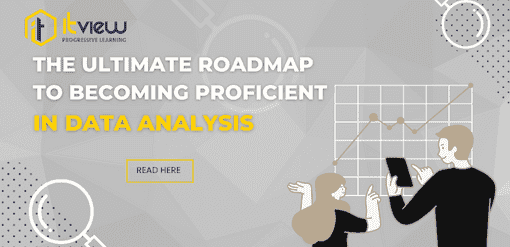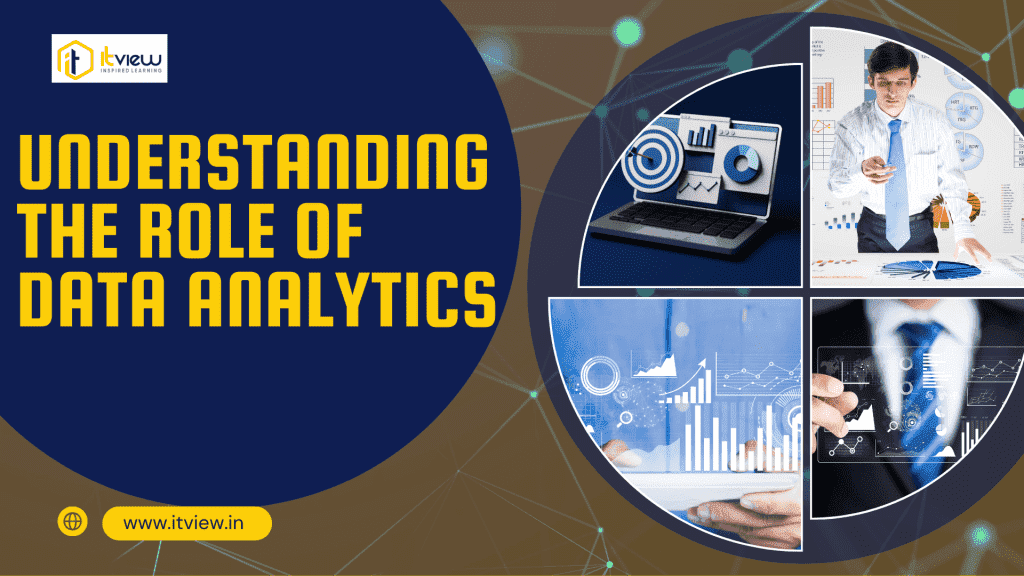I. Introduction to Data Analysis
A. What is Data Analysis?
Data analysis is the process of examining, cleaning, transforming, and interpreting data with the aim of deriving useful insights and making informed decisions. It involves various techniques and methods to uncover patterns, trends, correlations, and relationships within datasets. Data analysis can be performed using a wide range of tools and technologies, including statistical software, programming languages, and data visualization tools.
Discover the intricacies of data analysis by joining our esteemed beginner data analytics certification courses. Unlock deeper insights today!
B. Importance and applications of data analysis
Data analysis plays a crucial role in various fields and industries, including business, healthcare, finance, marketing, and scientific research. Some key importance and applications include:
Informed Decision Making: Data analysis provides valuable insights that help organizations and individuals make informed decisions based on evidence rather than probability or guesswork.
Improved Efficiency and Productivity: By analyzing data, organizations can identify inefficiencies, streamline processes, and optimize resources, leading to surpass efficiency and productivity.
Risk Management: Data analysis enables organizations to identify and lessen the risks by analyzing historical data, identifying potential risks, and developing strategies to manage them effectively.
Customer Insights: By analyzing customer data, businesses can gain insights into customer behaviour, preferences, and needs, allowing them to tailor products, services, and marketing strategies to better meet customer demands.
Predictive Analytics: Data analysis allows organizations to use historical data to make predictions about future events or trends, enabling them to anticipate changes and make proactive decisions.
C. Why proficiency in Data Analysis Matters
Proficiency in Data Analysis is essential for several reasons:
Competitive Advantage: In today\’s data-driven world, organizations that can effectively analyze and leverage data have a significant competitive advantage over those that cannot.
Career Opportunities: Proficiency in data analysis opens up a wide range of career opportunities in various industries, including data analyst, data scientist, business analyst, and market researcher.
Problem Solving: Data analysis provides a systematic approach to problem-solving, allowing individuals and organizations to identify root causes, develop solutions, and measure outcomes based on data-driven insights.
Innovation: Data analysis can uncover new opportunities, insights, and trends that can drive innovation and help organizations stay ahead of the curve in a rapidly changing marketplace.
Evidence-Based Decision Making: Proficiency in data analysis enables individuals and organizations to make evidence-based decisions, reducing the reliance on intuition or gut feeling and increasing the likelihood of success.
II. Getting Started with Data Analysis
Getting started with data analysis is an exciting journey that begins with laying a solid foundation. Here are the key points to consider as you embark on your data analysis adventure:
A. Understanding Basic Concepts and Terminology
Before diving into the world of data analysis, it\’s essential to grasp fundamental concepts and terminology. This includes understanding what data is, different types of data (such as numerical, categorical, and ordinal), and basic statistical measures like mean, median, and standard deviation. Additionally, familiarize yourself with key terms such as data visualization, exploratory data analysis, and predictive modeling. A clear understanding of these concepts will serve as the building blocks for your data analysis skills.
B. Tools and Software for Data Analysis
Next, explore the wide array of tools and software available for data analysis. Some popular options include Microsoft Excel, a versatile spreadsheet tool commonly used for basic data analysis and visualization. For more advanced analysis and programming capabilities, consider learning Python, a powerful programming language with rich libraries for data manipulation and analysis. R is another popular choice among statisticians and data scientists, offering extensive statistical capabilities and visualization tools. Depending on your specific needs and preferences, choose the tool or software that best suits your goals and objectives.
C. Setting Up Your Workspace and Environment
Once you\’ve selected your preferred tools and software, it\’s time to set up your workspace and environment for data analysis. This involves installing the necessary software on your computer and configuring it to meet your requirements. For Excel users, ensure you have the latest version installed and familiarize yourself with basic functions and features for data analysis. If you\’re diving into Python or R, install the appropriate IDE (Integrated Development Environment) or text editor, along with relevant libraries and packages for data analysis. Organize your files and folders in a structured manner to keep track of your data and analysis projects effectively.
By understanding basic concepts, exploring different tools and software, and setting up your workspace and environment, you\’ll be well-equipped to embark on your data analysis journey with confidence. Remember to stay curious, practice regularly, and never stop learning as you delve deeper into the fascinating world of data analysis.
III. Learning Fundamentals of Data Analysis
Mastering the fundamentals of data analysis is essential for anyone looking to derive meaningful insights from data. Here\’s a breakdown of key concepts and techniques to help you get started:
A. Exploratory Data Analysis Techniques
Exploratory data analysis (EDA) is the process of visually and statistically exploring datasets to understand their underlying structure, patterns, and relationships.
Techniques commonly used in EDA include:
Summary Statistics: Calculating basic statistics such as mean, median, mode, range, and variance to summarize the characteristics of the data.
Data Distribution: Visualizing the distribution of data using histograms, box plots, and density plots to understand its shape, central tendency, and spread.
Correlation Analysis: Examining the relationship between variables using correlation coefficients and scatter plots to identify patterns or associations.
Outlier Detection: Identifying outliers or anomalies in the data that may indicate errors, anomalies, or interesting insights.
By performing exploratory data analysis, analysts can gain valuable insights into the structure and characteristics of their data, guiding further analysis and decision-making processes.
B. Data Visualization Methods and Best Practices
Data visualization is a powerful tool for communicating insights and findings from data effectively. Some common data visualization methods and best practices include:
Choosing the Right Chart Types: Selecting appropriate chart types (e.g., bar charts, line charts, scatter plots) based on the type of data and the insights you want to convey.
Enhancing Readability: Ensuring visualizations are clear, concise, and easy to interpret by using appropriate labels, colors, and formatting.
Telling a Story: Crafting visualizations that tell a compelling narrative and highlight key findings or trends in the data.
Iterative Design: Iteratively refining and improving visualizations based on feedback and insights gained from stakeholders or audience members.
By mastering data visualization techniques and best practices, analysts can effectively communicate insights and findings to stakeholders, driving informed decision-making processes.
C. Statistical Concepts and Techniques
Statistical concepts and techniques form the foundation of data analysis, providing tools for summarizing, analyzing, and interpreting data. Key statistical concepts and techniques include:
Measures of Central Tendency: Calculating measures such as mean, median, and mode to describe the central tendency of a dataset.
Measures of Dispersion: Computing measures such as standard deviation, variance, and range to quantify the spread or variability of data values.
Hypothesis Testing: Formulating and testing hypotheses about population parameters using statistical tests such as t-tests, chi-square tests, and ANOVA.
Regression Analysis: Modeling the relationship between variables using regression techniques such as linear regression, logistic regression, and multiple regression.
By understanding statistical concepts and techniques, analysts can make informed decisions, draw reliable conclusions, and uncover valuable insights from data.
In summary, mastering the fundamentals of data analysis involves understanding exploratory data analysis techniques, mastering data visualization methods and best practices, and grasping key statistical concepts and techniques. By acquiring these skills, analysts can effectively explore, visualize, and analyze data to derive meaningful insights and drive informed decision-making processes.
IV. Intermediate Data Analysis Skills
As you progress in your data analysis journey, mastering intermediate-level skills is crucial for tackling more complex datasets and extracting deeper insights. Here\’s a closer look at two key areas of focus:
A. Data Cleaning and Preprocessing
Data cleaning and preprocessing are essential steps in data analysis to ensure data quality, consistency, and reliability. Some key techniques and practices include:
Handling Missing Data: Identifying and handling missing values using techniques such as imputation, deletion, or interpolation to prevent bias and ensure completeness of the dataset.
Data Transformation: Transforming and standardizing variables through techniques such as normalization, scaling, or encoding to improve model performance and interpretability.
Removing Outliers: Detecting and removing outliers or anomalies in the data that may skew analysis results or affect model accuracy.
Addressing Data Errors: Correcting errors or inconsistencies in the data arising from typos, duplicates, or formatting issues to maintain data integrity and reliability.
By cleaning and preprocessing data effectively, analysts can ensure the accuracy and reliability of their analysis results, leading to more robust and trustworthy insights.
B. Advanced Statistical Methods
Moving beyond basic statistical techniques, mastering advanced statistical methods allows analysts to uncover deeper insights and relationships within the data. Some key advanced statistical methods include:
Hypothesis Testing: Conducting hypothesis tests to make inferences about population parameters, such as comparing means or proportions between groups using techniques like t-tests or chi-square tests.
Regression Analysis: Performing regression analysis to model and analyze the relationship between variables, including linear regression, logistic regression, and multivariate regression models.
ANOVA and MANOVA: Conducting analysis of variance (ANOVA) or multivariate analysis of variance (MANOVA) to compare means across multiple groups and assess the impact of categorical variables on continuous outcomes.
Time Series Analysis: Analyzing time-series data to identify patterns, trends, and seasonal effects using techniques such as autoregression, moving averages, and exponential smoothing.
By mastering advanced statistical methods, analysts can gain deeper insights into the underlying relationships and patterns within the data, enabling more informed decision-making and predictive modeling.
In summary, mastering intermediate data analysis skills involves mastering data cleaning and preprocessing techniques to ensure data quality and reliability, as well as mastering advanced statistical methods to uncover deeper insights and relationships within the data. By acquiring these skills, analysts can tackle more complex datasets and extract valuable insights to drive business decisions and inform strategic initiatives.
C. Machine Learning Fundamentals for Data Analysis
Understanding the fundamentals of machine learning is crucial for leveraging advanced techniques to extract insights and make predictions from data. Some key concepts and techniques include:
Supervised Learning: Understanding the principles of supervised learning algorithms, such as linear regression, logistic regression, decision trees, and support vector machines, to build predictive models from labelled data.
Unsupervised Learning: Exploring unsupervised learning algorithms, including clustering techniques such as K-means clustering and hierarchical clustering, to identify patterns and structure within unlabeled data.
Model Evaluation and Validation: Learning techniques for evaluating and validating machine learning models, such as cross-validation, confusion matrices, and metrics like accuracy, precision, recall, and F1-score.
Feature Engineering: Understanding the importance of feature selection and feature engineering in improving model performance and reducing overfitting or underfitting.
By mastering machine learning fundamentals, analysts can apply advanced techniques to analyze complex datasets, make accurate predictions, and uncover valuable insights to drive decision-making processes.
V. Advanced Data Analysis Techniques
As you progress further in your data analysis journey, it\’s essential to master advanced techniques to extract deeper insights and make more accurate predictions from your data. Here are three key areas of focus for advanced data analysis:
A. Time Series Analysis and Forecasting
Time series analysis involves analyzing data collected over time to identify patterns, trends, and seasonality. Forecasting, on the other hand, involves using historical data to predict future values. Some key techniques in time series analysis and forecasting include:
Decomposition: Decomposing a time series into its components, such as trend, seasonality, and noise, to better understand its underlying patterns.
Exponential Smoothing: Applying exponential smoothing techniques, such as simple exponential smoothing, double exponential smoothing, or triple exponential smoothing (Holt-Winters method), to make short-term forecasts.
ARIMA Modeling: Using Autoregressive Integrated Moving Average (ARIMA) models to capture and model the underlying structure and dynamics of time series data for forecasting purposes.
Prophet: Leveraging the Prophet library developed by Facebook for time series forecasting, which provides a user-friendly interface and handles seasonality and holiday effects automatically.
By mastering time series analysis and forecasting techniques, analysts can make accurate predictions and informed decisions based on temporal data trends.
B. Predictive Modeling and Classification
Predictive modeling involves building statistical models to predict future outcomes or trends based on historical data. Classification, a specific type of predictive modeling, involves categorizing data into distinct classes or categories. Some key techniques in predictive modeling and classification include:
Regression Analysis: Using regression techniques, such as linear regression, polynomial regression, or ridge regression, to model the relationship between variables and make predictions about continuous outcomes.
Decision Trees: Constructing decision tree models to classify data into categories based on a series of binary decisions, enabling interpretable and easy-to-understand models.
Random Forests: Building ensemble models, such as random forests, which combine multiple decision trees to improve predictive accuracy and robustness.
Support Vector Machines (SVM): Employing SVM algorithms to classify data by finding the optimal hyperplane that separates different classes in the feature space.
By mastering predictive modeling and classification techniques, analysts can build accurate models to predict future outcomes and make data-driven decisions across various domains and industries.
C. Text Mining and Sentiment Analysis
Text mining involves extracting valuable insights and patterns from unstructured text data, while sentiment analysis focuses on analyzing opinions, attitudes, and emotions expressed in text. Some key techniques in text mining and sentiment analysis include:
Natural Language Processing (NLP): Applying NLP techniques, such as tokenization, stemming, and lemmatization, to preprocess and clean text data for analysis.
Bag-of-Words (BoW): Representing text data as numerical vectors using the bag-of-words model, which counts the frequency of words in a document.
TF-IDF (Term Frequency-Inverse Document Frequency): Using TF-IDF weighting to assign weights to words based on their importance in a document relative to a corpus of documents.
Sentiment Analysis: Analyzing sentiment in text data using techniques such as lexicon-based methods, machine learning approaches, or deep learning models to classify text as positive, negative, or neutral.
By mastering text mining and sentiment analysis techniques, analysts can extract valuable insights from textual data sources such as social media, customer reviews, and surveys, enabling organizations to understand customer sentiment and make informed decisions.
Discover all the essentials of data analysis and data analytics by enrolling in our beginner data analytics courses tailored for freshers. Start your journey today!
VI. Practical Applications and Case Studies
A. Real-world examples demonstrating data analysis techniques
Explore real-world case studies showcasing various data analytics techniques in action with our data analytics course. From analyzing customer behavior to predicting market trends, delve into practical examples that illustrate the power and impact of data analytics across different industries and domains.
B. Hands-on projects and exercises for skill reinforcement
Engage in hands-on projects and exercises designed to reinforce your data analytics skills. Apply theoretical knowledge to practical scenarios, manipulate real datasets, and practice analytical techniques to gain confidence and proficiency in data analytics.
C. Discussion of challenges and best practices in data analysis
Discuss the challenges and best practices encountered in data analytics in our beginner data analytics courses. Learn from our experienced professionals as they share insights on overcoming common obstacles, optimizing analytical processes, and navigating ethical considerations in data-driven decision-making.
VII. Refining Your Data Analysis Skills
A. Continuous learning resources and communities
Discover continuous learning resources and communities dedicated to advancing your data analytics skills. Access to our data analytics courses and professional networks to stay updated on the latest trends, tools, and techniques in data analytics.
B. Strategies for staying updated with evolving technologies and techniques
Explore strategies for staying updated with evolving technologies and techniques in data analytics. From attending conferences and workshops to following thought leaders and industry publications, discover effective ways to keep pace with the rapidly changing landscape of data analytics.



